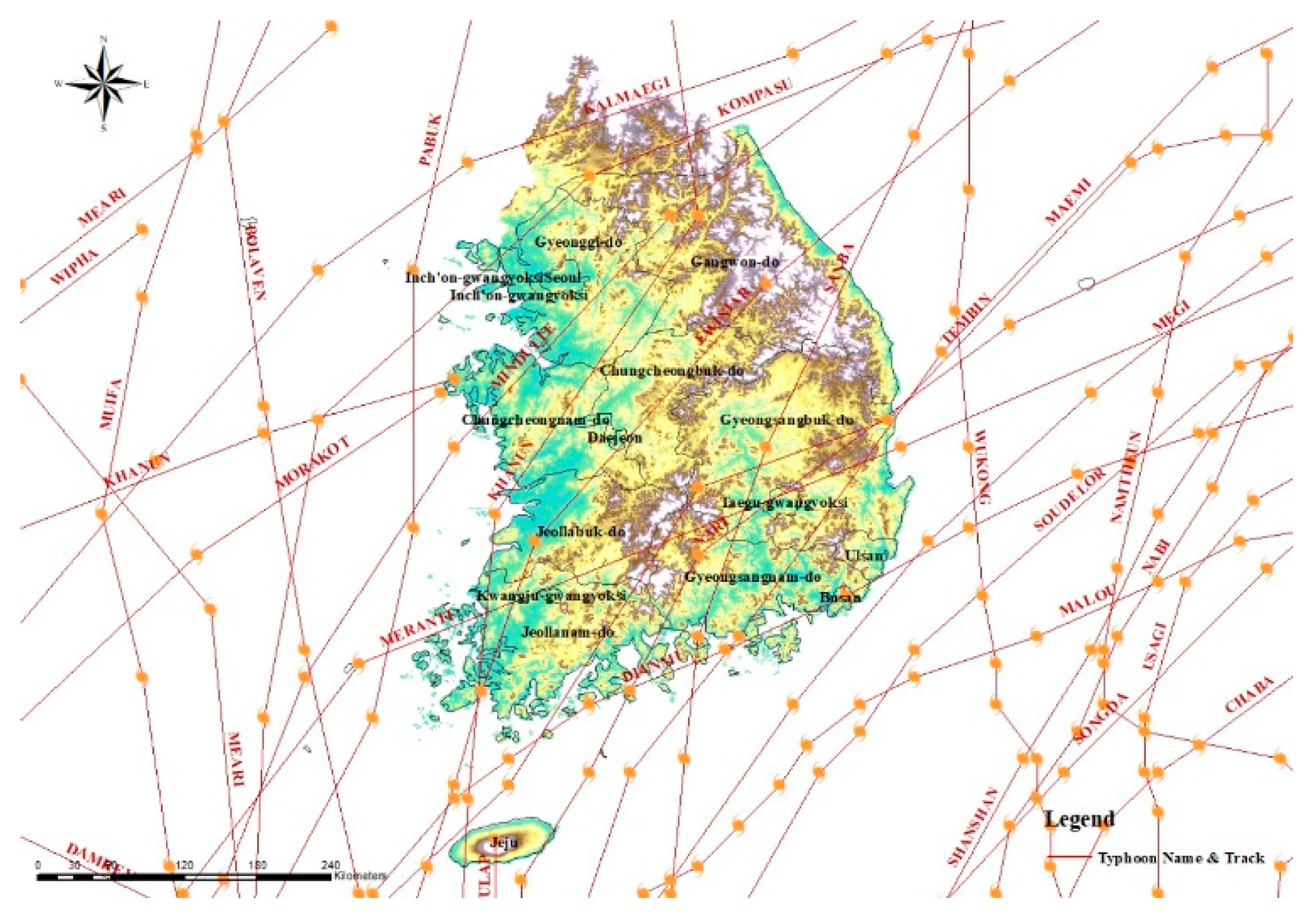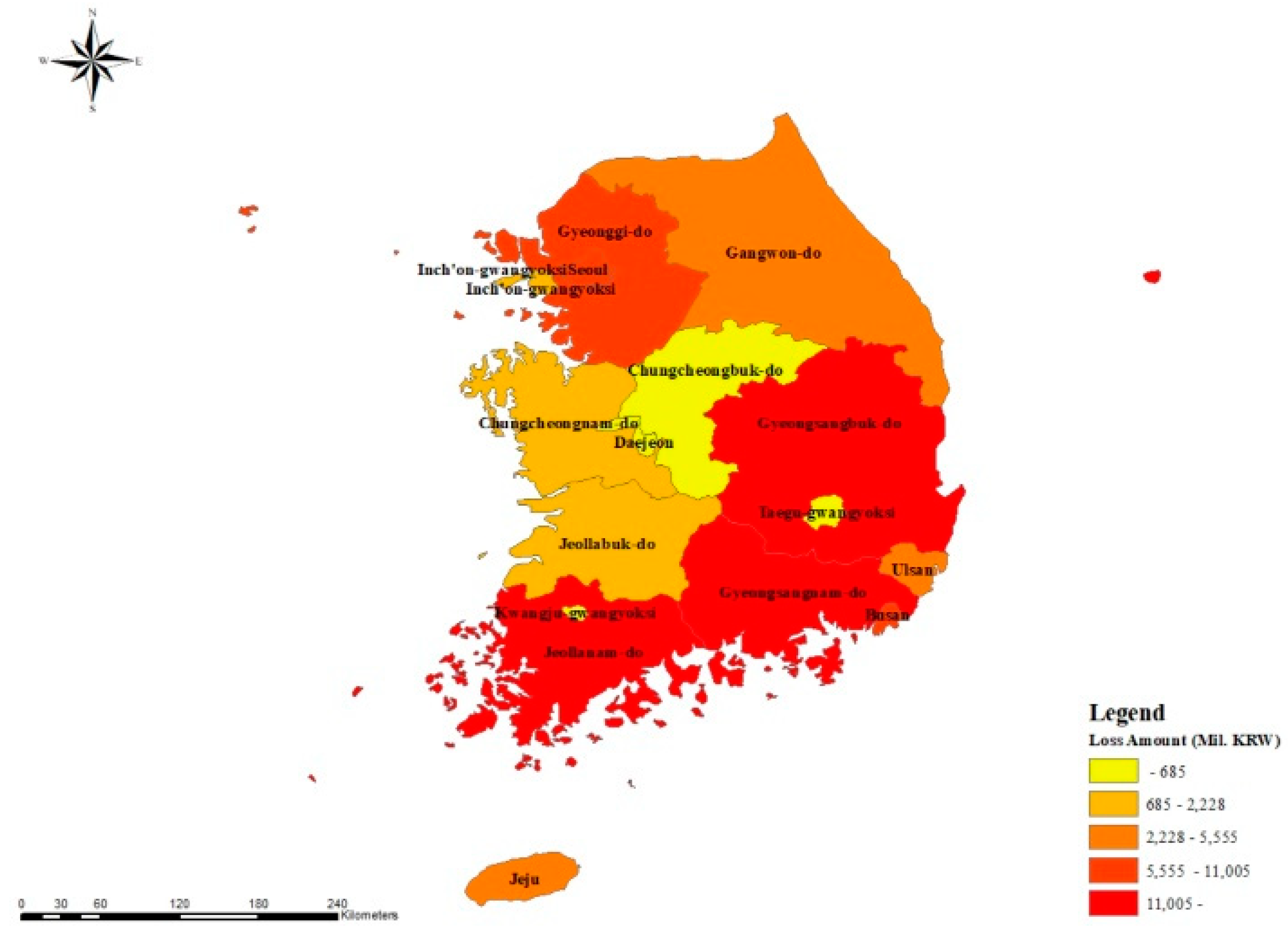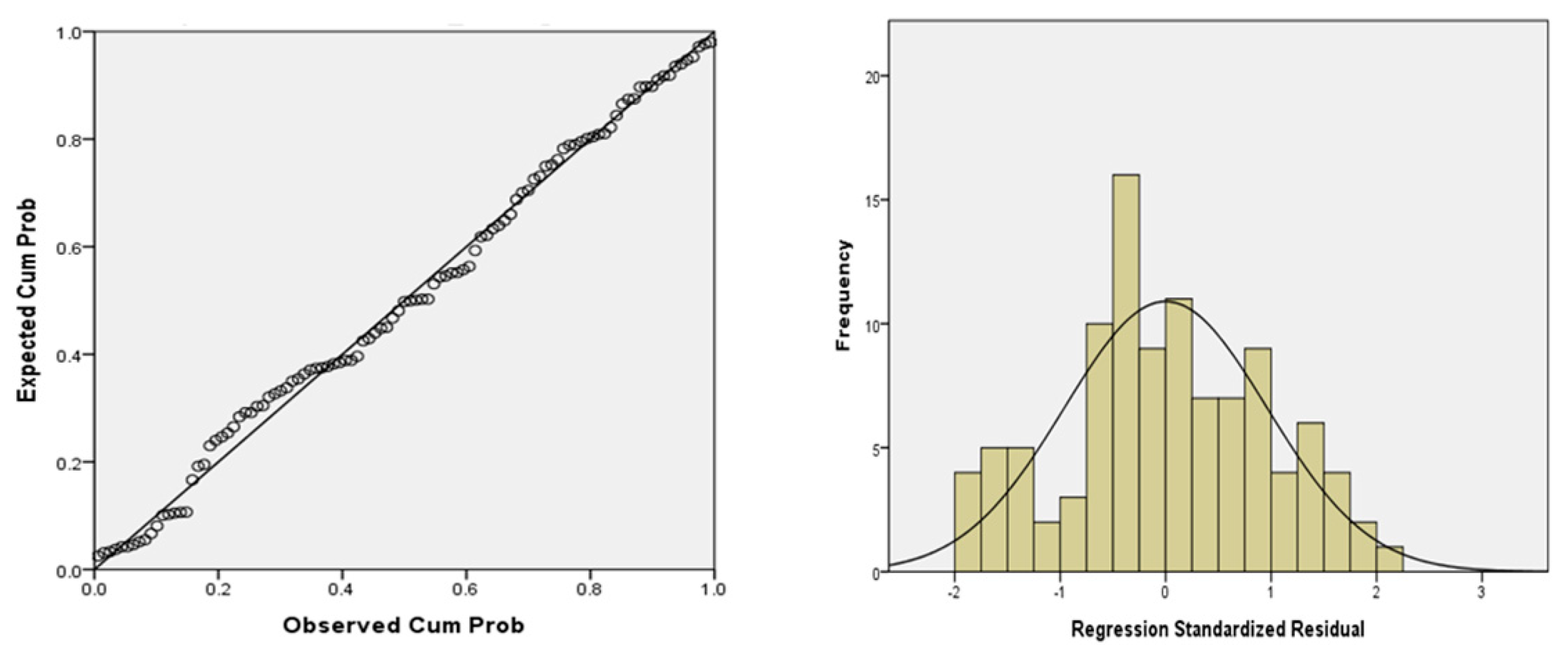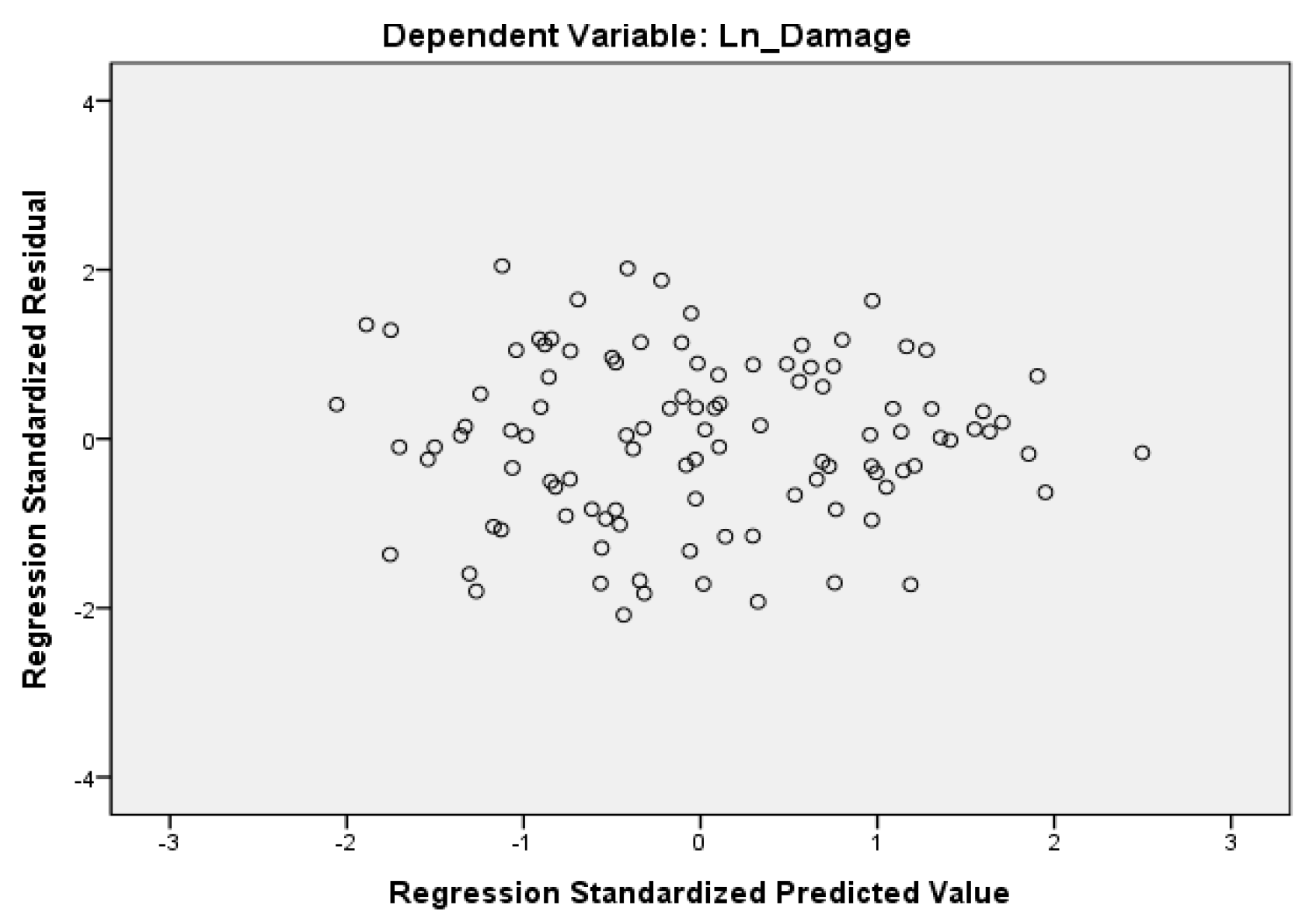Identifying Risk Indicators of Building Damage Due to Typhoons: Focusing on Cases of South Korea
Abstract
1. Introduction
2. Research Method and Design
2.1. Dependent Variable
2.2. Independent Variable
2.2.1. Meteorological Indicators
2.2.2. Geographic Vulnerability Indicators
2.2.3. Built Environment Vulnerability Indicators
2.2.4. Socioeconomic Vulnerability Indicators
3. Data Collection and Analysis
3.1. Multiple Regression Analysis and Results
3.2. Investigation of the Model
4. Discussion
5. Conclusions
Author Contributions
Acknowledgments
Conflicts of Interest
References
- Yeon, H.J.; Jeong, K.C.A. Statistical Analysis of the Relationship among Frequency, Intensity, and Damage of Natural Hazard. Korean Rev. Crisis Emerg. Manag. 2018, 14, 149–156. [Google Scholar] [CrossRef]
- Ministry of Public Safety and Security. 2016 Yearbook of Disasters. Available online: http://www.korea.kr/common/download.do?tblKey=EDN&fileId=212054 (accessed on 7 December 2017).
- Hurricane Research Division. How Many Hurricanes Have There Been in Each Month? Available online: http://www.aoml.noaa.gov/hrd/ (accessed on 30 July 2017).
- Kim, J.M.; Kim, T.; Son, K. Revealing building vulnerability to windstorms through an insurance claim payout prediction model: A case study in South Korea. Geomat. Nat. Hazards Risk 2017, 8, 1333–1341. [Google Scholar] [CrossRef]
- Crichton, D. The risk triangle. Nat. Disaster Manag. 1999, 1, 102–103. [Google Scholar]
- Lee, S.S.; Chang, E.M. Application of GIS to typhoon risk assessment. J. Korean Spat. Inf. Soc. 2009, 17, 243–249. [Google Scholar]
- Lee, S.I. A Study on Damage Scale Prediction by Rainfall and Wind Velocity with Typhoon. Master’s Thesis, Sunchon National University, Suncheon, Korea, February 2013. [Google Scholar]
- Kim, J.S. On the Characteristics of Damage Scale and Risk Management System by Strong-Wind Speed of Typhoon. Master’s Thesis, Inje University, Gimhae, Korea, February 2013. [Google Scholar]
- Jeon, H.D.; Park, M.J.; Kim, K.Y. Damage analysis of meteorological disasters for each district considering the characteristics of a district. J. Korean Soc. Hazard Mitig. 2008, 8, 75–82. [Google Scholar]
- Lee, D.Y.; Kim, I.J. A study on typhoon damage prevention measures about the facility of the rural areas. J. Korean Inst. Rural Archit. 2012, 14, 117–124. [Google Scholar]
- Highfield, W.E.; Peacock, W.G.; Van Zandt, S. Determinants & Characteristics of Damage in Single-Family Island Households from Hurricane Ike1. Available online: https://law.utexas.edu/publicinterest/activities/fhdocs/Determinants_Damage_Van_Zandt.pdf (accessed on 22 May 2017).
- Burton, C.G. Social vulnerability and hurricane impact modeling. Nat. Hazards Rev. 2010, 11, 58–68. [Google Scholar] [CrossRef]
- Kim, J.; Woods, P.; Park, Y.; Son, K. Estimating the Texas Windstorm Insurance Association claim payout of commercial buildings from Hurricane Ike. Nat. Hazards 2016, 84, 405–424. [Google Scholar] [CrossRef]
- Sparks, P.R.; Schiff, S.; Reinhold, T. Wind damage to envelopes of houses and consequent insurance losses. J. Wind Eng. Ind. Aerodyn. 1994, 53, 145–155. [Google Scholar] [CrossRef]
- Dunion, J.P.; Landsea, C.W.; Houston, S.H.; Powell, M.D. A reanalysis of the surface winds for Hurricane Donna of 1960. Mon. Weather Rev. 2003, 131, 1992–2011. [Google Scholar] [CrossRef]
- Vickery, P.J.; Skerlj, P.F.; Lin, J.; Twisdale, L.A., Jr.; Young, M.A.; Lavelle, F.M. HAZUS-MH hurricane model methodology. II: Damage and loss estimation. Nat. Hazards Rev. 2006, 7, 94–103. [Google Scholar] [CrossRef]
- Huang, Z.; Rosowsky, D.; Sparks, P. Hurricane simulation techniques for the evaluation of wind-speeds and expected insurance losses. J. Wind Eng. Ind. Aerodyn. 2001, 89, 605–617. [Google Scholar] [CrossRef]
- Watson, C.C., Jr.; Johnson, M.E. Hurricane loss estimation models. Bull. Am. Meteorol. Soc. 2004, 65, 1713–1726. [Google Scholar] [CrossRef]
- Rego, J.L.; Li, C. On the importance of the forward speed of hurricanes in storm surge forecasting: A numerical study. Geophys. Res. Lett. 2009, 36, 1–5. [Google Scholar] [CrossRef]
- Brody, S.D.; Zahran, S.; Highfield, W.E.; Grover, H.; Vedlitz, A. Identifying the impact of the built environment on flood damage in Texas. Disasters 2008, 32, 1–18. [Google Scholar] [CrossRef] [PubMed]
- Choi, O.; Fisher, A. The impacts of socioeconomic development and climate change on severe weather catastrophe losses: Mid-Atlantic Region (MAR) and the US. Clim. Chang. 2003, 58, 149–170. [Google Scholar] [CrossRef]
- Cutter, S.L. Vulnerability to environmental hazards. Prog. Hum. Geogr. 1996, 20, 529–539. [Google Scholar] [CrossRef]
- Khanduri, A.; Morrow, G. Vulnerability of buildings to windstorms and insurance loss estimation. J. Wind Eng. Ind. Aerodyn. 2003, 91, 455–467. [Google Scholar] [CrossRef]
- Kim, J.M.; Woods, P.K.; Park, Y.J.; Kim, T.; Son, K. Predicting hurricane wind damage by claim payout based on Hurricane Ike in Texas. Geomatics. Nat. Hazards Risk 2015, 7, 1–13. [Google Scholar]
- Cui, B.; Wang, C.; Tao, W.; You, Z. River channel network design for drought and flood control: A case study of Xiaoqinghe River basin, Jinan City, China. J. Env. Manag. 2009, 90, 3675–3686. [Google Scholar] [CrossRef] [PubMed]
- Zhai, G.; Fukuzono, T.; Ikeda, S. Multi-attribute evaluation of flood management in Japan: A choice experiment approach. Water Environ. J. 2007, 21, 265–274. [Google Scholar] [CrossRef]
- Dai, F.; Lee, C.; Ngai, Y.Y. Landslide risk assessment and management: An overview. Eng. Geol. 2002, 64, 65–87. [Google Scholar] [CrossRef]
- Ayalew, L.; Yamagishi, H. The application of GIS-based logistic regression for landslide susceptibility mapping in the Kakuda-Yahiko Mountains, Central Japan. Geomorphology 2005, 65, 15–31. [Google Scholar] [CrossRef]
- Chock, G.Y.K. Modeling of hurricane damage for Hawaii residential construction. J. Wind Eng. Ind. Aerodyn. 2005, 93, 603–622. [Google Scholar] [CrossRef]
- Social Science Research Network (SSRN). Do Coastal Building Codes Mitigate Hurricane Damage to Residential Property? Available online: http://ssrn.com/abstract=928009 (accessed on 12 December 2017).
- De Silva, D.G.; Kruse, J.B.; Wang, Y. Spatial dependencies in wind-related housing damage. Nat. Hazards 2008, 47, 317–330. [Google Scholar] [CrossRef]
- Cutter, S.L.; Boruff, B.J.; Shirley, W.L. Social vulnerability to environmental hazards. Soc. Sci. Q. 2003, 84, 242–261. [Google Scholar] [CrossRef]
- Dixon, R.W.; Fitzsimons, D.E. Toward a quantified hurricane vulnerability assessment for Texas coastal counties. Texas J. Sci. 2001, 53, 345–352. [Google Scholar]
- Myers, C.A.; Slack, T.; Singelmann, J. Social vulnerability and migration in the wake of disaster: The case of Hurricanes Katrina and Rita. Popul. Environ. 2008, 29, 271–291. [Google Scholar] [CrossRef]
- Tate, E.; Cutter, S.L.; Berry, M. Integrated multi hazard mapping. Environment and planning. B Plan. Des. 2010, 37, 646–663. [Google Scholar]
- Wu, S.Y.; Yarnal, B.; Fisher, A. Vulnerability of coastal communities to sea-level rise: A case study of Cape May County, New Jersey, USA. Clim. Res. 2002, 22, 255–270. [Google Scholar] [CrossRef]
- Cardona, O.D. Indicators of Disaster Risk and Risk Management: Program for Latin America and the Caribbean: Summary Report. Available online: https://publications.iadb.org/bitstream/handle/11319/4801/Indicators%20of%20Disaster%20Risk%20and%20Risk%20Management.pdf?sequence=1&isAllowed=y (accessed on 1 January 2017).
- Mileti, D. Disasters by Design: A Reassessment of Natural Hazards in the United States, 1st ed.; Eric, K., Noji, M.D., Eds.; A Joseph Henry Press: Washington, DC, USA, 1999. [Google Scholar]
- De Sherbinin, A.; Schiller, A.; Pulsipher, A. The vulnerability of global cities to climate hazards. Environ. Urban 2007, 19, 39–64. [Google Scholar] [CrossRef]
- Zahran, S.; Shelley, T.O.C.; Peek, L.; Brody, S.D. Natural disasters and social order: Modeling crime outcomes in Florida. Int. J. Mass Emerg. Disasters 2009, 27, 26–52. [Google Scholar]
- Korea Meteorological Association. Available online: http://kma.go.kr (accessed on 1 January 2017).
- Korea Hydrographic and Oceanographic Agency. Available online: http://www.khoa.go.kr (accessed on 1 January 2017).
- Korean Statistical Information Service. Available online: http://kosis.kr (accessed on 1 January 2017).
- Korean National Police Agency. Available online: http://www.police.go.kr (accessed on 1 January 2017).
- Hua, H.; Vineet, J.; Guillermo, L.; Cagdas, K. Modeling Relative Spatial and Temporal Hurricane Wind Vulnerability of the Building Stock in the US. In Proceedings of the Americas Conference on Wind Engineering, San Juan, Puerto Rico, 22–26 June 2009. [Google Scholar]
- AIR Worldwide. AIR Hurricane Model for the United States. Available online: https://www.air-worldwide.com/ (accessed on 1 October 2018).




| Region | Total Damages (Mil.KRW) | Typhoon Name (Amount of Damage) |
|---|---|---|
| Gyongsangnam-do | 47,556 | Maemi (46,218), Sanba (931), Nari (150), Bolaven (136), Diamu (75), Muifa (44) |
| Jeollanam-do | 35,635 | Bolaven (20,841), Maemi (11,003), Nari (1,875), Sanba (964), Khanun (606), Meari (150), Kompasu (135), Diamu (45), Malou (15) |
| Gyongsangbuk-do | 18,548 | Maemi (13,767), Nari (3,015), Sanba (1506), Meari (78), Shanshan (75), Bolaven (46), Kompasu (30), Malou (15), Usagi (15) |
| Gyeonggi-do | 11,005 | Muifa (9099), Kompasu (1200), Bolaven (301), Meari (255), Kalmaegi (105), Sanba (18), Diamu (15), Khanun (9), Usagi (0.1) |
| Busan | 10,950 | Maemi (10,374), Muifa (420), Sanba (121), Nari (18), Diamu (15) |
| Seoul | 9328 | Muifa (9236), Malou (45), Meari (44), Khanun (1) |
| Gangweon-do | 5555 | Maemi (5346), Muifa (87), Nari (45), Bolaven (30), Kompasu (15), Usagi (15), Sanba (11.4), Meari (5) |
| Jeju | 3740 | Nari (1740), Maemi (1492), Bolaven (359), Sanba (72), Diamu (45), Kompasu (15), Malou (15) |
| Ulsan | 2229 | Maemi (1538), Nari (625), Sanba (64), Meari (0.6) |
| Jeollabuk-do | 2228 | Bolaven (2008), Nari (60), Sanba (60), Maemi (54), Kalmaegi (15), Khanun (15), Kompasu (15) |
| Incheon | 1665 | Muifa (1261), Kompasu (120), Meari (103), Kalmaegi (90), Bolaven (75), Khanun (13) |
| Chungcheongnam-do | 1556 | Bolaven (1382), Nari (75), Kalmaegi (60), Sanba (16), Muifa (15), Kompasu (7), Meari (0.6) |
| Gwangju | 685 | Bolaven (654), Khanun (15), Kompasu (15) |
| Daegu | 629 | Maemi (552), Nari (75), Daejun (15), Khanun (15), Sanba (1.2) |
| Chungcheongbuk-do | 469 | Bolaven (211), Nari (60), Meari (46), Kompasu (45), Maemi (30), Usagi (30), Sanba (15), Kalmaegi (15), Muifa (15) |
| Category | Variables | Previous Studies | Description | Unit | Source |
|---|---|---|---|---|---|
| Meteorological | Forward motion speed | Burton (2010) [12] Vickery et al. (2006) [16] Huang et al. (2001) [17] Watson and Johnson (2004) [18] Rego and Li (2009) [19] | Typhoon’s forward motion speed | km/h | Korea Meteorological Association [41] |
| Maximum wind speed | 10 min sustained maximum wind speed | m/s | |||
| Radius of maximum wind speed | Radius of maximum wind speed (over 15 m/s) | km | |||
| Precipitation | Brody et al. (2008) [20] Choi and Fisher (2003) [21] | Total amount of precipitation | mm/day | ||
| Geographical | Length of coastline | Highfield et al. (2010) [20] | Total length of coastline | km | Korea Hydrographic and Oceanographic Agency [42] |
| Built environment | Cutting slope | Ayalew and Yamagishi (2005) [28] | Total number of cutting slope | Number per [1000 m2] | Korean Statistical Information Service [43] |
| High rise building | Khanduri and Morrow (2003) [23] De Silva et al. (2008) [31] | Total number of high rise building (over 20 m) | Number | ||
| Socio-economic | Violent crime | De Sherbinin et al. (2007) [39] Zahran et al. (2009) [40] | Total number of violent crime (murder, rob, rape, and arson) | Number | Korean National Police Agency [44] |
| Variables | Minimum | Maximum | Mean | Std. Deviation |
|---|---|---|---|---|
| Dependent | ||||
| Building Damage (Mil.KRW) | 0.06 | 46218.72 | 1517.89 | 5495.65 |
| Independent | ||||
| Forward Movement Speed | 20 | 52 | 32.06 | 9.7 |
| Wind Speed | 17 | 44 | 32.13 | 7.19 |
| Radius of Wind Speed | 150 | 600 | 357.05 | 118.76 |
| Precipitation | 0 | 420 | 85.24 | 78.62 |
| Length of coastline | 0 | 2104 | 515.16 | 618.57 |
| Cutting Slope | 0 | 69 | 25.03 | 24.86 |
| High rise building | 370 | 33,462 | 5339.48 | 6888.31 |
| Crime | 3376 | 5090 | 3900.69 | 458.01 |
| Model | Sum of Squares | Mean Square | F | Sig. | R2 | Adj-R2 |
|---|---|---|---|---|---|---|
| Regression | 480.531 | 60.066 | 10.835 | 0.000 | 0.474 | 0.431 |
| Residual | 532.199 | 5.544 | ||||
| Total | 1012.730 |
| Variables | Β | Std. Error | Beta | Sig. | VIF |
|---|---|---|---|---|---|
| Constant | 2.552 | 2.862 | 0.000 | ||
| Meteorological Indicators | |||||
| Forward movement speed | 0.062 | 0.025 | 0.193 | 0.014 | 1.087 |
| (Wind Speed)2 | 0.001 | 0.001 | 0.201 | 0.016 | 1.225 |
| Radius of max. wind speed | 0.011 | 0.002 | 0.411 | 0.000 | 1.425 |
| Precipitation | 0.014 | 0.003 | 0.349 | 0.000 | 1.113 |
| Geographical Indicator | |||||
| Coastline | 0.001 | 0.000 | 0.230 | 0.005 | 1.164 |
| Built environment Indicator | |||||
| Cutting slope | 0.029 | 0.010 | 0.233 | 0.005 | 1.206 |
| High rise building | −8.231 × 10−5 | 0.000 | 0.182 | 0.062 | 1.690 |
| Socio-economic Indicator | |||||
| Crime | 0.001 | 0.001 | 0.196 | 0.052 | 1.806 |
| Dependent Variable | Kolmogorov–Smirnov | Shapiro–Wilk | ||
|---|---|---|---|---|
| Statistic | Sig. | Statistic | Sig. | |
| Ln (Building Damage) | 0.026 | 0.200 | 0.974 | 0.027 |
© 2018 by the authors. Licensee MDPI, Basel, Switzerland. This article is an open access article distributed under the terms and conditions of the Creative Commons Attribution (CC BY) license (http://creativecommons.org/licenses/by/4.0/).
Share and Cite
Kim, J.-M.; Son, K.; Yoo, Y.; Lee, D.; Kim, D.Y. Identifying Risk Indicators of Building Damage Due to Typhoons: Focusing on Cases of South Korea. Sustainability 2018, 10, 3947. https://doi.org/10.3390/su10113947
Kim J-M, Son K, Yoo Y, Lee D, Kim DY. Identifying Risk Indicators of Building Damage Due to Typhoons: Focusing on Cases of South Korea. Sustainability. 2018; 10(11):3947. https://doi.org/10.3390/su10113947
Chicago/Turabian StyleKim, Ji-Myong, Kiyoung Son, Youngmi Yoo, Donghoon Lee, and Dae Young Kim. 2018. "Identifying Risk Indicators of Building Damage Due to Typhoons: Focusing on Cases of South Korea" Sustainability 10, no. 11: 3947. https://doi.org/10.3390/su10113947
APA StyleKim, J.-M., Son, K., Yoo, Y., Lee, D., & Kim, D. Y. (2018). Identifying Risk Indicators of Building Damage Due to Typhoons: Focusing on Cases of South Korea. Sustainability, 10(11), 3947. https://doi.org/10.3390/su10113947






